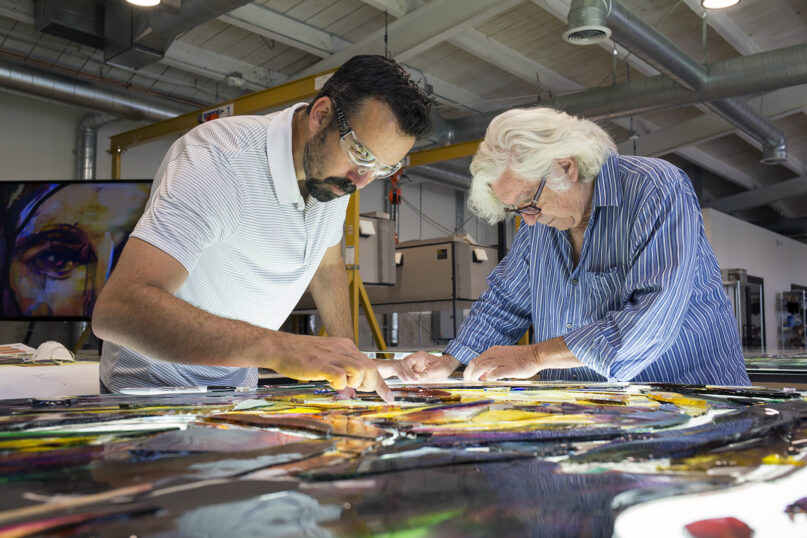(RNS) — When family-run, Los Angeles-based Judson Studios beat out firms in Italy and Germany for the bid to create one of the world’s largest stained-glass windows for the biggest Mainline church in America, it felt almost miraculous.
There was just one problem: They didn’t know how to make it.
Spanning roughly 100 by 35 feet and made of 161 glass panels, the colossal window would be the focal point of the new $90 million church building for United Methodist Church of the Resurrection, led by influential pastor Adam Hamilton in Leawood, Kansas. The winning proposal by project designer Tim Carey depicted a towering, muti-colored Christ surrounded by over 90 saints, leaders and biblical figures. And it featured brilliant swirls of overlapping colors that the studio had never attempted before.
“When you have an opportunity to do something amazing, you do everything you can in your power to make it happen,” Carey told RNS. “I just had this drive to keep going, thinking to myself, we’ll figure this out.”
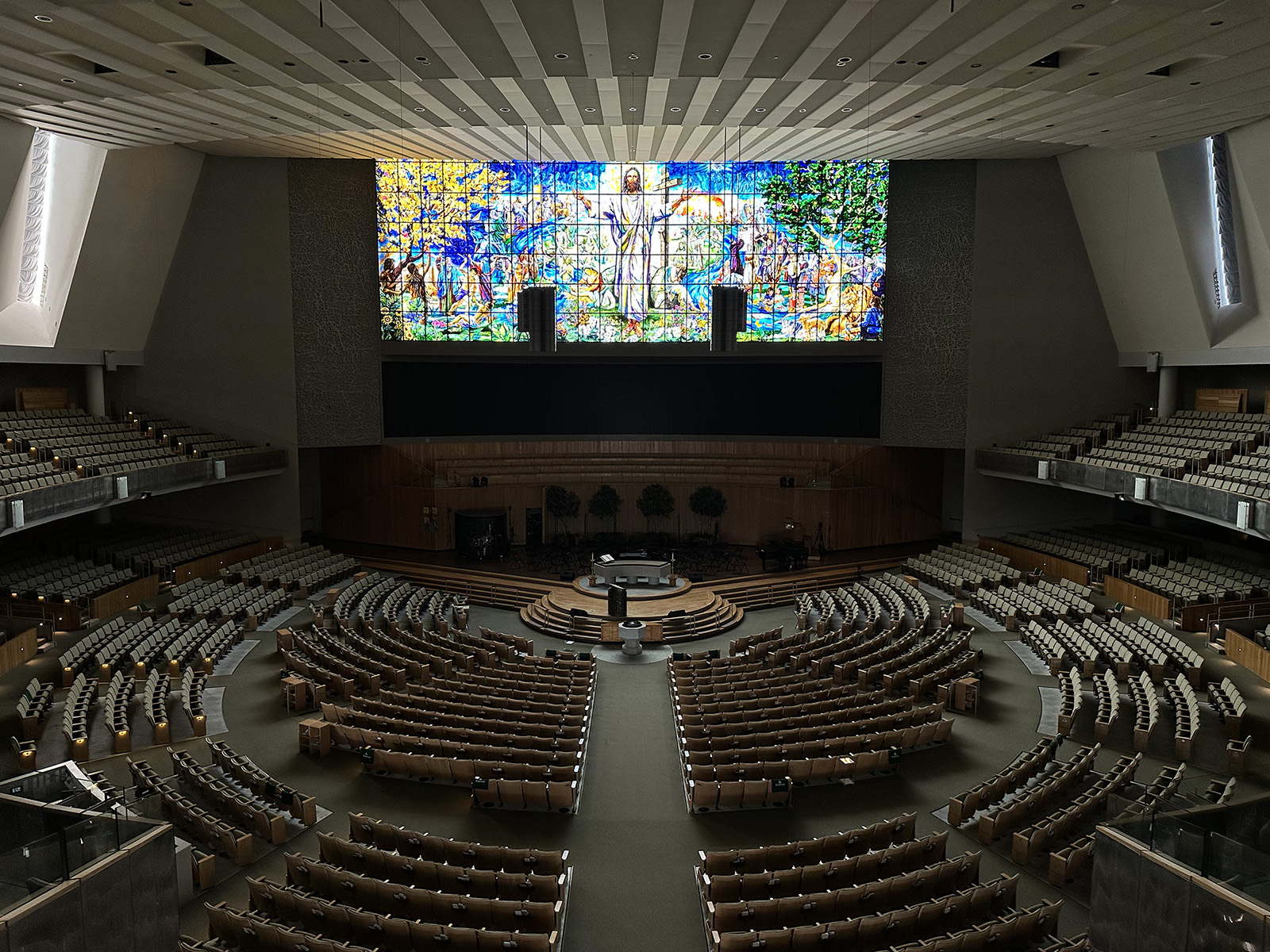
The sanctuary of United Methodist Church of the Resurrection in Leawood, Kansas. (RNS photo/Kit Doyle)
Enter Narcissus Quagliata, a 70-something master craftsman with a shock of white hair and a penchant for interjecting unwelcome opinions. At Carey’s invitation, Quagliata flew into Judson Studios, butting heads with Carey while passing on the skill he’d perfected: creating brushstrokes out of fused glass. The key to this artform? Bits of ground glass, called frit.
Filmed between fall 2014 and summer 2018, the documentary “Holy Frit,” now hitting select theaters, captures the awe and frenzy of Judson Studios’ race against time to build the largest fused-glass window. The film also traces Carey’s fledgling Christian faith, grapples with whether a church should spend $4 million on a window and embraces questions about divine influence, all while recording Carey’s emphatic, profane reactions to glass cuts and setbacks.
“As a religious person, I think that we’re messy. Humans are messy. And what I loved about this film is that it was this tension between the reverent and the irreverent all the way through,” filmmaker Justin Monroe told Religion News Service. Monroe said the film’s name was in part an ode to the integral role of the frit in crafting the window — “it was a holy part of the process,” he said — and a nod to “a phrase you might utter when you’re really angry.”
Monroe first stumbled across the idea for the documentary nearly a decade ago, when Carey, his next-door neighbor in Los Angeles, asked Monroe to film a promotional video for Judson Studios’ pitch to build the biggest stained-glass window of its kind.
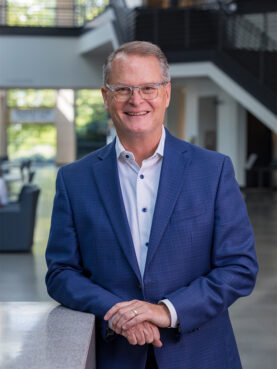
The Rev. Adam Hamilton. (Photo courtesy Church of the Resurrection)
Hamilton, senior pastor of United Methodist Church of the Resurrection, told RNS the church never set out to build a massive window. The size was simply to accommodate the space left after the architects designed their new sanctuary, which seats 35,000 people.
“Our hope was the moment you walked in, it sort of arrested you, stopped you in your tracks, and that you felt the presence of Christ and that you heard the gospel, even if there was no one else in the room — that the building and the architecture and the stained glass window would speak,” said Hamilton.
Carey drafted over 70 sketches for the design, and the final version — with images referencing the Garden of Eden, Gethsemane and the restored garden of paradise — won the church’s approval. The next step was figuring out how to make it happen.
Even after completing the successful promo video, Monroe knew watching Judson Studios rise to the challenge of the project would be worth documenting. For the next four years, he filmed the artists almost constantly.
“I wasn’t filming the window being made,” he said. “I was, but they were my art, they were my window. I was interested in their dynamic and their story and the struggles they were going through as humans doing something bigger than themselves.”
The narrative only grew more compelling once Quagliata arrived on the scene as a non-religious savior figure. Though he and Carey clashed on politics, religion and even how much time should be spent in the studio — in one scene, Quagliata tells Carey he should give up seeing his family on weekends to finish the project on time — the two were eventually in lockstep when it came to the aesthetic goals of the project, thanks in part to their shared backgrounds in fine art.
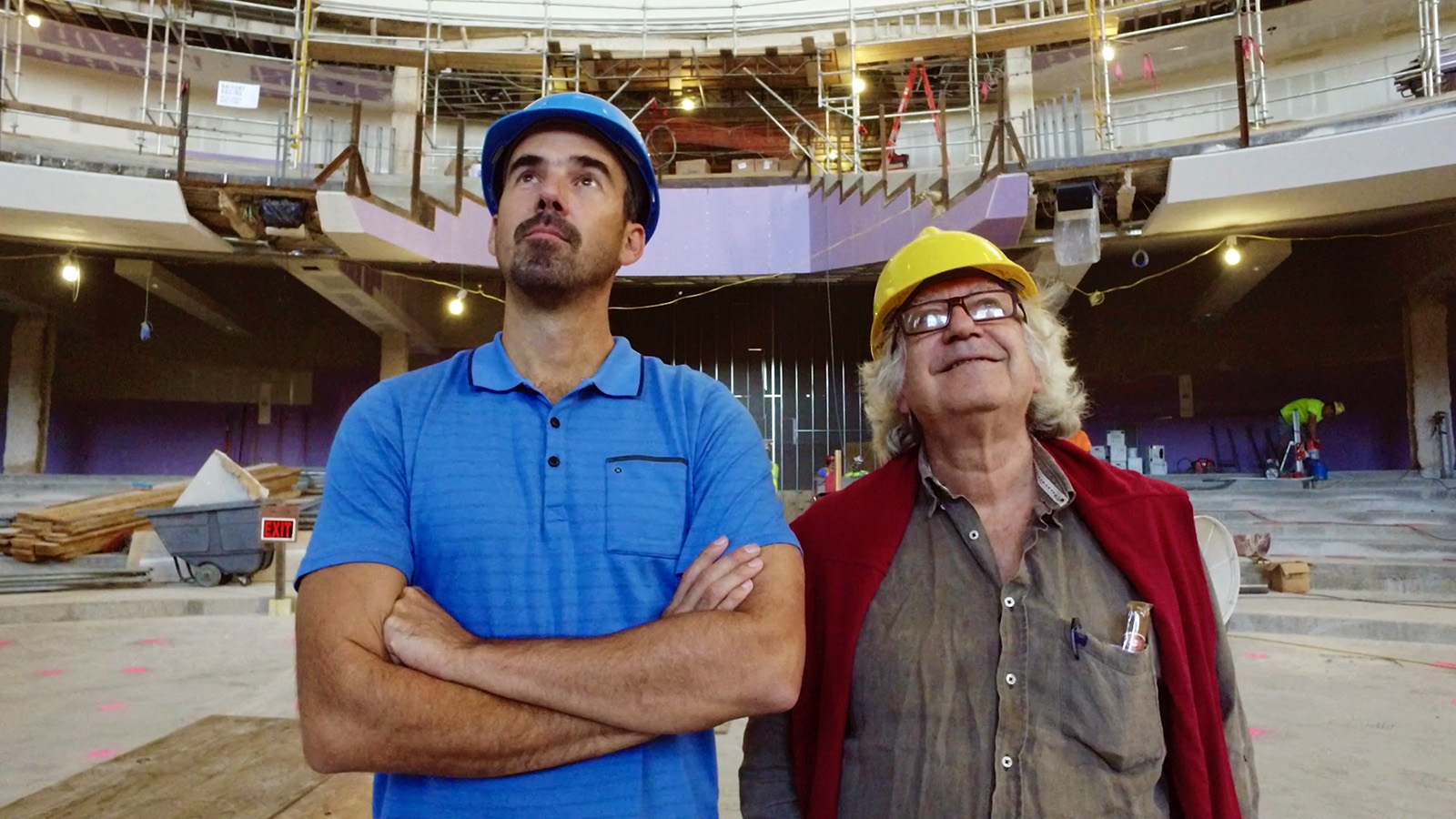
Tim Carey, left, and Narcissus Quagliata watch the installation of their stained-glass window in the “Holy Frit” documentary at Church of the Resurrection in Leawood, Kansas. (Photo courtesy Abramorama)
Even with Quagliata as a secret weapon, the journey to complete the window is suffused with tension and suspense. Will Quagliata ever trust Carey to lay the frit? Will they get the face of Christ right? What happens when the kiln breaks? What if the church doesn’t raise enough funds for the design?
“I don’t think we did fully know, until I saw the film, just how uncertain the reality of them finishing this was, at least in the timeframe they needed to finish,” Hamilton laughed.
The team dynamics are also complex, with Carey at times feeling under-appreciated by his boss, David Judson, and eventually choosing to leave to start Tim Carey Studio. Looking back, Carey told RNS that watching that part of the film can be difficult, especially because he’s in such a different place now.
“But then I get to look back at things like me having a beautiful mustache,” Carey joked about watching the film. “That makes up for it.”
Quirky as the documentary may be, it’s also, subtly, about faith. The artists consider whether God is also involved, at some level, in the project and reflect on the spiritual impact of spending years of their lives creating a religious masterpiece.
Carey told RNS that when you’re designing a stained-glass window for a church, you tend to spend a lot of time with the Bible. “So there was that part of it for me, just a really specific learning and understanding of what my faith was and where it comes from, which I think strengthened it,” said Carey. “And as an artist, it’s an amazing thing to be able to be part of the legacy of Christian art. Some of the greatest paintings, the greatest pieces of art, were done as part of the church and the growth of the church.”
With the completion of the Resurrection Window in 2017, Carey’s artwork has already irrevocably impacted the congregation at Church of the Resurrection.
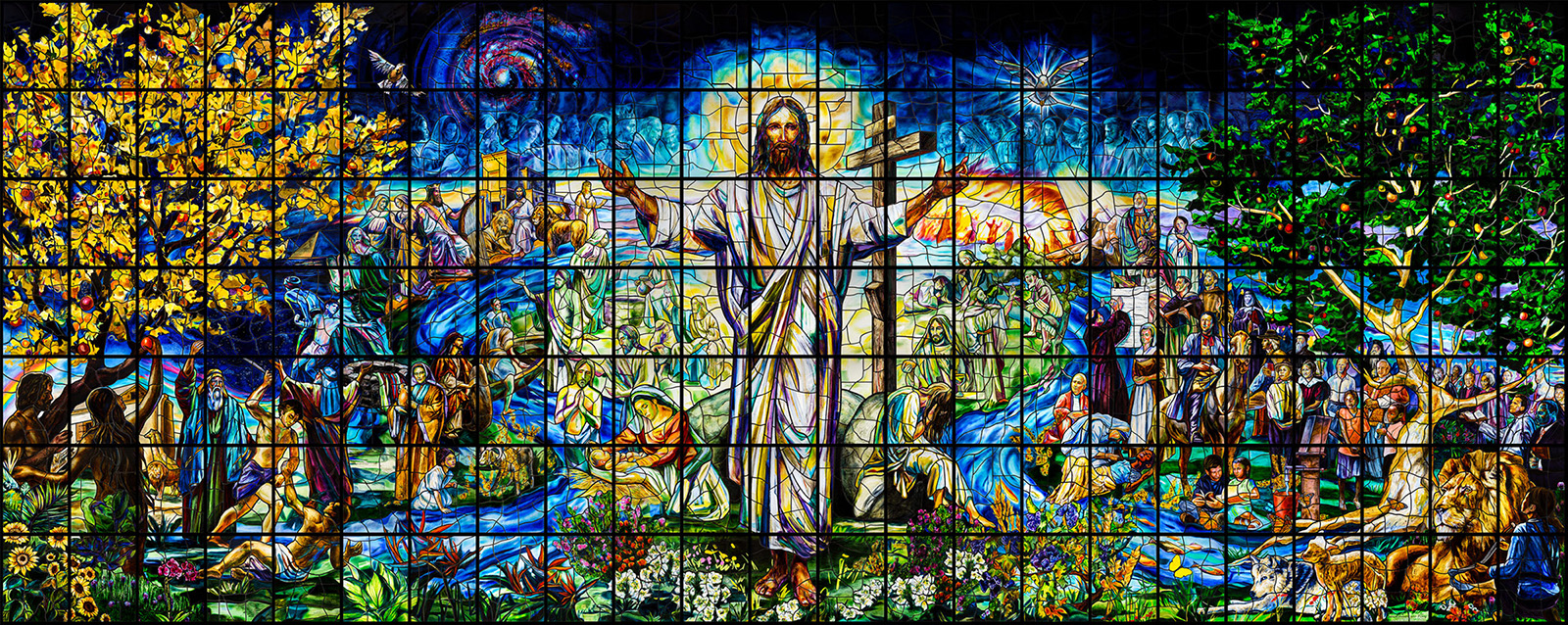
The full stained-glass window at Church of the Resurrection in Leawood, Kansas. (Photo courtesy Judson Studios)
“Every day there are people who walk in the building, to just come to see the stained-glass window,” said Hamilton, who estimated that at least 50,000 different people had come to worship at the church since 2017. The more the congregation grows, Hamilton pointed out, the more they are able to support ministries outside their church. Each year the church donates 25% of their income, and the chief financial officer has estimated that by 2037, the church will have given $185 million back to the community.
The window has also influenced the stained-glass industry, where fusing is continuing to gain traction as an art form. Though there’s some debate about whether the Resurrection Window is the largest stained-glass window, period, it’s safe to say that it is certainly the world’s biggest fused-glass window.
“I don’t care,” Carey told RNS. “It’s a huge, freaking window.”
The documentary, which won the Audience Award when it premiered at the 2021 Sundance Film Festival, is currently in the midst of its limited theatrical release. The fact that people are viewing the film in theaters is remarkable to Monroe, who at times doubted whether anyone would watch a movie about a church window. “But I knew that it wasn’t just about the glass,” he said.
Though Monroe wrapped up filming the documentary in 2018, he never really stopped filming Carey. Now, the duo have launched a Youtube Channel called Vitreonics that combines Carey’s deadpan humor with the wonder of the glass world. Their hope is for the series to culminate in a TV show that carries on the wild world captured in “Holy Frit.”
“There’s something magically, beautifully weird and wonderful about this process,” Monroe told RNS. “Watching things break and come together and fall apart and be remade.”
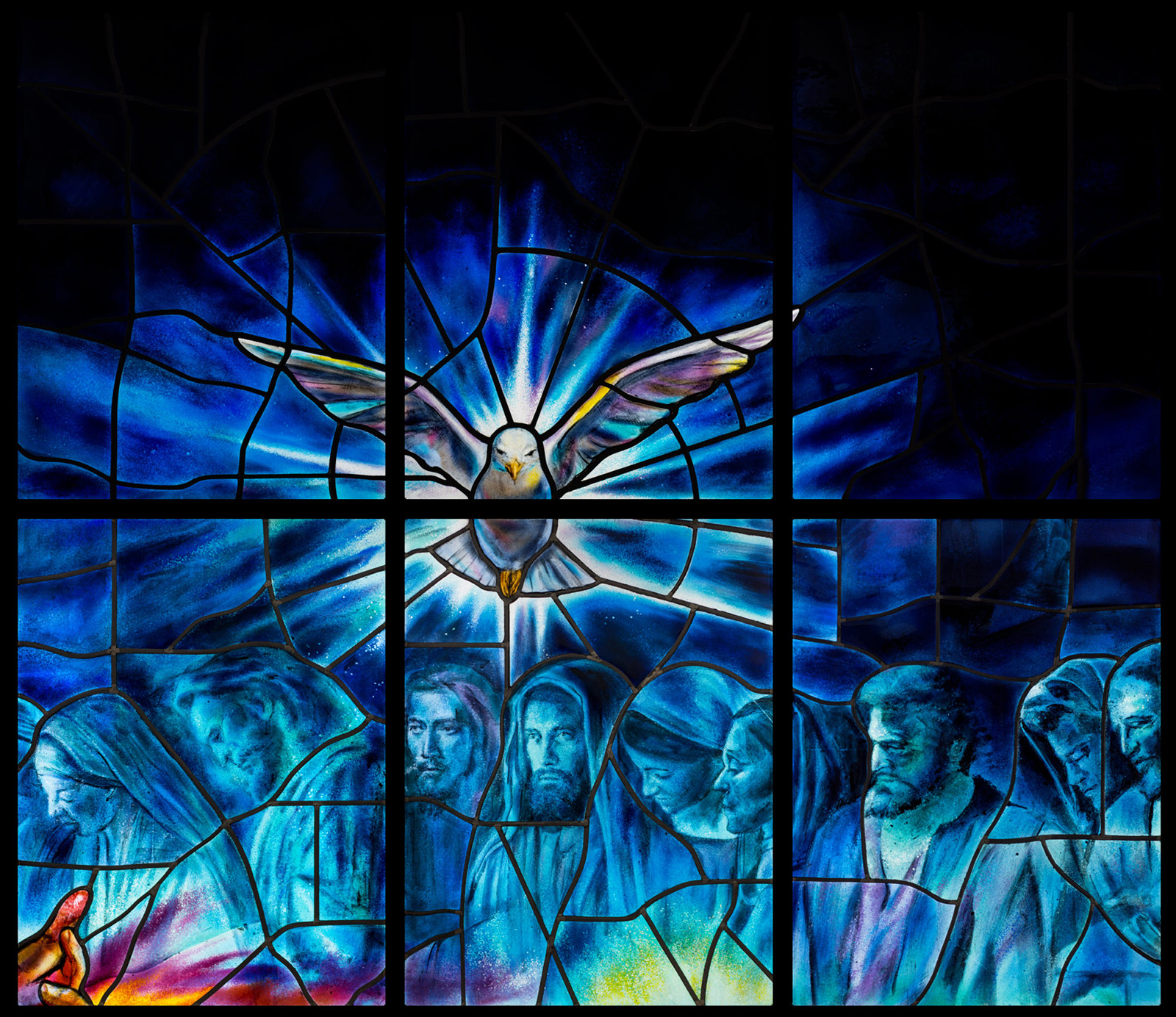
A dove and several panels of the stained-glass window at Church of the Resurrection in Leawood, Kansas. (Photo courtesy Judson Studios)
